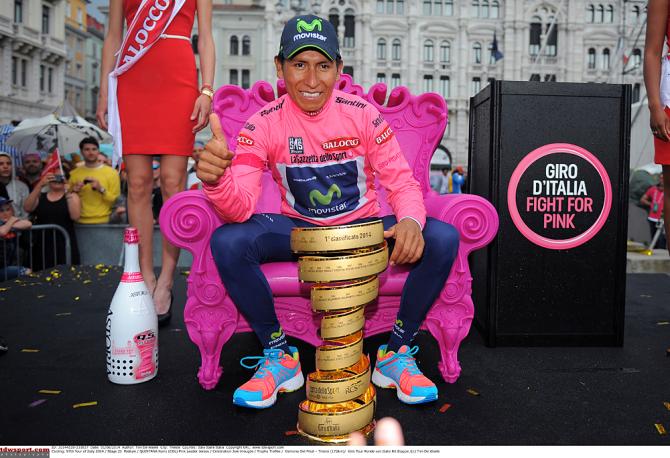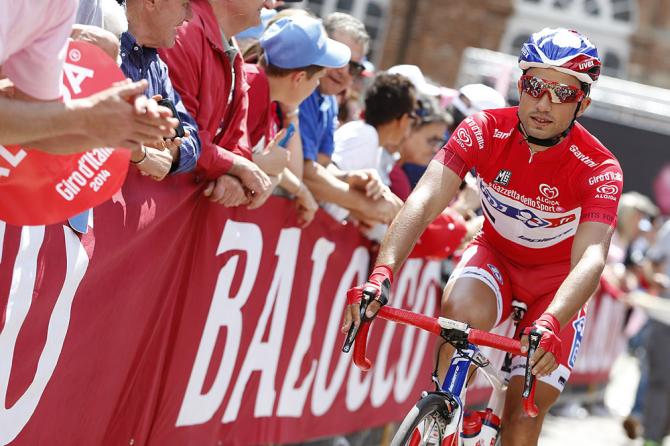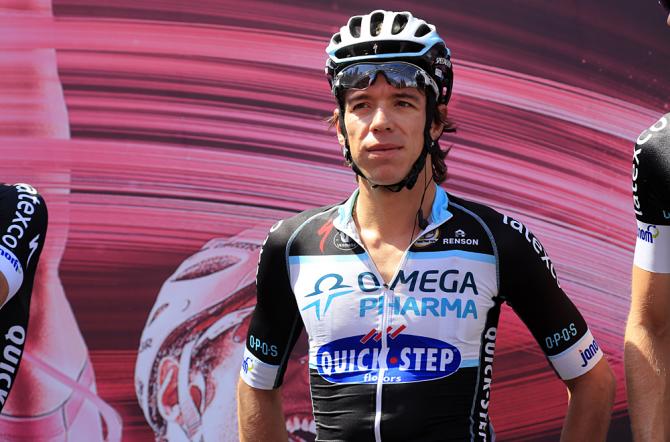Top 10 conclusions from the Giro d'Italia
A look back at three weeks of Grand Tour racing



Cyclingnews' Stephen Farrand and Barry Ryan take a look back at what we learned from three weeks of racing at the 2014 Giro d'Italia. Check out their conclusions below.
1. Quintana right to target the Giro d'Italia
Nairo Quintana and his Movistar team managers thought long and hard before deciding to target the Giro d'Italia in 2014 rather than return to the Tour de France.
As they savour their victory, the decision has proven to be the right one. Quintana confirmed his huge potential and made history as the first Colombian to win the Giro d'Italia. He has matured massively in the last three weeks and learnt a lot about Grand Tour racing and team leadership.
Quintana has already made it clear that he will ride the Tour de France in 2015 and he will now be a natural favourite. Chris Froome, Alberto Contador and Vincenzo Nibali must already be having nightmares about trying to stay on Quintana's back wheel when he goes on the attack in the mountains.
2. A Giro of generational change
It would be unwise to describe this year's Giro d'Italia as a race of renewal or as a clean start after the doping scandals of the past, but the race marked a major generational change.
Get The Leadout Newsletter
The latest race content, interviews, features, reviews and expert buying guides, direct to your inbox!
Quintana is just 24, Fabio Aru is 23 and Rigoberto is 27, making an average age of just 25 years and two months, apparently the youngest Giro d'Italia podium since 1940, when Fausto Coppi won his first of five Giro d'Italia at just 21.
Older riders like Michele Scarponi, Ivan Basso, Cadel Evans, Franco Pellizotti and Damiano Cunego have been eclipsed by Quintana, Aru, Rafal Majka, Wilco Kelderman and Robert Kiserlovski.
3. Aru versus Nibali: the next great Italian rivalry
Fabio Aru was supposed to help Michele Scarponi at the Giro d'Italia and continue his apprenticeship as Italy's next great stage race talent. His third place overall, his solo stage win on Montecampione, his friendly demeanor and Italy's desperate need for a new face, have suddenly elevated him to star status and future "campione".
Aru modestly plays down his achievements and future ambitions but questions about a possible rivalry with Astana teammate Vincenzo Nibali have already been made.
Like Nibali, Aru is under contract with Astana for 2015, with a reported contract of 500,000 euros per season, but that has not stopped Gazzetta dello Sport suggesting that BMC and Team Sky are ready to offer him two million euros per year.
Any move could depend on if Aru has a get-out clause in his contract or if Astana is willing to let him go in exchange for cash. If he stays at Astana he could target the Giro d'Italia in 2015, with Nibali again focusing on the Tour. However they could clash in other races and both could want the full affection and clamour of the tifosi.
4. A cast of thousands is better than one prima donna
Giro d'Italia race director Mauro Vegni did everything he could to try and convince Vincenzo Nibali to return to the race after dominating the 2013 edition, worried that the race would lacked a star rider.
However at the finish in Trieste, Vegni was all smiles after one of the most entertaining editions of the Corsa Rosa for years.
Last year, Nibali was so strong and so superior that the Giro d'Italia was decided before the final week in the mountains had even begun. This year Nairo Quintana was a big-name winner and had to fight almost until Trieste before celebrating victory. The battle for top 10 places was like a game of snakes and ladders, with riders rising, falling and fighting for places throughout the race.
The start in Ireland, the rain, the polemics, the sprints, the crashes, the attacks, the mountains, the crowds, the attacks, the racing and especially the riders, made the 2014 Giro d'Italia a very exciting race. Who needs a star rider and a prima donna, when you can have a cast of thousands?
The Giro d'Italia may be over and both Rigoberto Uran and Fabio Aru admitted that Nairo Quintana would have won the pink jersey without his attack on the descent of the Stelvio. Yet the echo of the polemica can still be heard in the mountains and the peloton.
Riders vented their anger about what happened on stage 16 and the risks they took by riding in the cold and snow almost as much as they thanked their sponsors and teammates. Directeur sportifs are still angry and embarrassed that some of their rivals flicked them and Omega Pharma-QuickStep manager Patrick is still threatening to get a lawyer.
The only lasting consequence is that several riders and teams scored more UCI WorldTour points than would have if the break never got away on the descent of the Stelvio. Teams that are worried about their WorldTour status are worried that every point could be vital to their future.
The best possible consequence of #Stelviogate would be for the UCI to sit down with the teams, riders and race organizers and rewrite the rule book, making clear provision for racing in extreme weather and setting rules that work and can be understood without problem by a modern peloton competing in a modern sport.
6. Bouhanni adds to his value
Marcel Kittel was the best sprinter in the Giro d'Irlanda, but once he went home and the race hit Italians roads, the mass finishes were all about Nacer Bouhanni (FDJ.fr). After a string of near misses in his Giro debut 12 months ago, Bouhanni hit almost all of his lines this time around, winning in Bari, Foligno and Salsomaggiore, and claiming the points classification to boot.
Each victory had an added resonance for the young Frenchman. Out of contract at the end of this season, and with Arnaud Démare also in the FDJ stable, it remains to be seen if Bouhanni will get the nod to face off against the likes of Kittel and Mark Cavendish at the Tour de France next month.
Bouhanni's agent has claimed that "six or seven teams" have expressed an interest in signing him. Among them was Cannondale, although manager Roberto Amadio balked at the idea of paying over one million euro per year in salary. "We were prepared to pay €700,000 or €800,000, but not more," he told L'Équipe at the start of the Giro. Bouhanni's success since will have strengthened his negotiating position, although in any case, he won't come cheap, with at least some of his existing lead-out train likely to be part of any deal.
7. The sun sets on Basso, Scarponi and Cunego
The youthful air to the upper reaches of the general classification can only have hammered home the message for a trio of veteran former winners of the race. Ivan Basso, Michele Scarponi and Damiano Cunego all lined up in Belfast with overall ambitions of one degree or another but they come away facing a wholesale rescaling of their targets.
There may have been mitigation for Scarponi - the crash at Montecassino compromised his race and eventually forced him to abandon - but the emergence of Fabio Aru means that his role at Astana is as a gregario di lusso and nothing more, with Vincenzo Nibali also in the ranks. Basso (15th overall) also seems to be resigned to his fate and the Italian has been linked with a move to Tinkoff-Saxo next season to ride in support of Alberto Contador.
For Cunego, meanwhile, it was an utterly nondescript Giro. Ten years on from his surprise victory in 2004, the Italian reached Trieste in 19th place overall in a race where he was completely outshone by his young teammate Diego Ulissi. Cunego has spent much of his career seemingly unsure if he is better suited to the Classics or the Grand Tours, and on the evidence of this spring, new Lampre manager Brent Copeland does not seem to have come any closer to solving that conundrum.
8. Evans at his limit
It was very much a Giro of two halves for the Cadel Evans - up until the Barolo time trial, he could scarcely put a pedal stroke wrong, but from there on in, his race descended into a long, hard struggle. In spite of slipping out of the maglia rosa and then off the podium, Evans stuck resolutely to his task throughout the race, finally claiming eighth place in Trieste.
Like Basso, Scarponi and Cunego, Evans will come away from this Giro carefully pondering his next move, although he wisely refrained from making any declarations in Gemona on the morning of the final stage. His victory at the Giro del Trentino beforehand raised hopes, but Evans must sense that winning another Grand Tour is probably beyond him. At 37 years of age, the Australian has to decide whether he is happy to continue his career with revised ambitions. The Vuelta a España in September will tell us more.
9. "New world" dominates the Giro
Orica-GreenEdge's decision to designate Svein Tuft as the first man over the line in the Belfast team time trial was met with indignation by some in the Italian press, who felt that the Giro should have been "honoured" by having national champion Ivan Santaromita wear the first maglia rosa of the race.
As it turned out, that was about as close as any Italian - or European, for that matter - got to holding the overall lead. In modern cycling, there are no gifts, not least for those from the Old Continent. For the first time in the Giro's history, no European wore the maglia rosa, which was instead held by a Canadian (Tuft), two Australians (Evans and Matthews) and two Colombians (Quintana and Uran) over the three weeks.
The statistic is simply another reflection of cycling's increasing internationalization. Ten years ago, the Giro was a resolutely Italian affair, almost a local event fought out between riders who rarely troubled the overall rankings at the Tour in July. The Giro's recent roll call of international protagonists - men like Quintana, Contador, Evans, Cavendish and Wiggins - shows how it has shed itself of the insularity of the pre-WorldTour era. The Giro now belongs to the world.
10. Quiet confidence the hallmark for Quintana
When Quintana finished second at the Tour de France last year, he impressed by pushing Chris Froome - and himself - beyond the limit on Mont Ventoux and in the Alps, but his inscrutable face betrayed no sign of suffering and his softly-spoken interviews seemed to tell us little about the man.
The Italian press duly christened Quintana "the Sphinx" in the opening half of the race, but as the Giro progressed, so too did the Colombian's reserved but quietly confident personality come to the fore. Indeed, his Giro win was impressive not just for the startling physical feats at Val Martello and Cima Grappa, but for the assuredness with which he carried the maglia rosa, on and off the bike.
Quintana never flinched in the wake of the Stelvio polemica - "I don't know if what they are saying is a joke, it makes me laugh," he said - and he controlled the race and the media attention with equanimity that belied his 24 years. His voice in post-race press conferences was as low decibel as ever, but his answers were always thoughtful and to the point. Last year's Tour confirmed the talent. This year's Giro revealed the character.